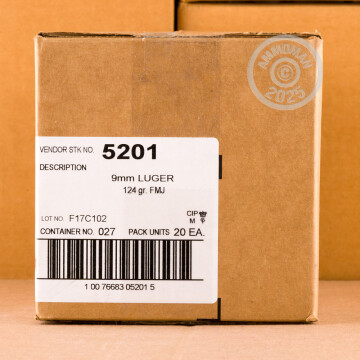Understanding Hollow Point vs FMJ Bullets
Different guns are better suited to different tasks. It’s rather hard to carry a full-sized rifle grocery shopping, and making a 300 yard shot with a defensive pistol is a bit of a challenge. It’s that same way with ammunition. Different types of cartridges have different tasks too. Different types of bullets are designed to accomplish different tasks. Two of the most common types of bullets are the jacketed hollow point (JHP) rounds and full metal jacket (JHP) bullets. Let’s get a better understanding of the differences between hollow point and FMJ bullets. We’ll see how each of them fit into your armed lifestyle.
Let’s begin by defining some terms. Ammunition consists of four parts. There is a tendency to use “bullet” to describe a complete round of ammunition, when in reality “bullet” is just a part of one round of ammunition. The first part is the case, also known as the shell. That’s the metal (or occasionally polymer) part that holds everything else together. At the bottom end of the shell casing is the primer. The gun’s firing pin strikes it and everything gets started. After the primer is struck, it ignites the powder (the third part of a round of ammo), which burns really quickly. This makes a lot of hot gasses that push the last part, the bullet, out of the barrel quickly.
The Naming Of Parts
There are also names for each part of a bullet. Both FMJ and JHP bullets are “jacketed.” This means they have a thin layer of copper that surrounds the lead that’s inside the bullet itself.
The base (or shank) is the part of the bullet that is stuffed into the cartridge to make a complete round of ammunition. The nose is at the other end, and hits the target first. The shape of the nose usually determines if a bullet is a hollow point or FMJ round.
So when we say “bullet,” what we mean is the part that actually gets shot out of a gun. It’s also the part that hits the target, and that’s where the differences with hollow point vs. fmj bullets really start to show up. Hollow point/JHP bullets are purpose-built to slow down and release their energy when they hit something meaty, such as a hunter’s prey or the person trying to kill you. They accomplish this task with their hollow point, which fills up and expands open when the bullet strikes something substantial. That expansion slows them down inside the target, which dumps all their energy into what they’ve hit. Even a small, lower-powered round like .22 rifle has over 100 ft/lbs of energy when fired, so whatever you hit is going to feel a thump.
The Function of Hollow Point vs FMJ Rounds
Full Metal Jacket (FMJ) rounds, on the other hand, are not meant to interact with the target in any meaningful way. Rather, their job is to punch a hole in whatever they hit and travel as far a distance as possible. FMJ bullets are easier to design and manufacture than JHP bullets, and as such, each round of FMJ ammo usually costs less per round than a round of JHP ammunition.
However, just because they’re not designed to slow down inside a target doesn’t mean FMJ bullets are useless for self defense. You need to hit the vital areas to be certain of stopping your attacker. That means the bullet penetrates through parts of the human body that are designed to stop penetration (like bones/muscle).
The FBI did an exhaustive study as to just how much penetration is needed to reach the important parts. Their tests determined that 12 inches of penetration into ballistics gel is the minimum requirement for an effective defensive round.
Different Bullets For Different Reasons

Ammo makers design hollow point rounds to open up when they hit something soft. FMJ rounds tend to retain their shape.
This becomes a problem for lower-powered cartridges such as 22 Magnum. The difference in penetration of hollow point vs FMJ bullets means that a JHP round will open up too soon and not hit the vital parts of an attacker. If you’re considering owning a gun like the Kel-Tec PMR-30 as a self-defense gun, consider using FMJ rounds as your defensive ammo of choice. This should penetrate more effectively than most JHP ammo. For other, more powerful calibers (9mm and up), hollow points are definitely the way to go.
To get a better understanding of the difference between hollow point vs FMJ bullets, we’re going to use the same methods to test the impact (literally) of each type of bullet into a standardized testing medium. In our case, we’ll use 10% synthetic ballistics gel. Clear Ballistics makes this gel specifically to serve as a yardstick for measuring the penetration of bullets into the human torso.
We’ll be shooting two different 380 ACP rounds: Three rounds of Blazer Brass FMJ, and three rounds of Federal Hydra Shok JHP ammunition. We’ll shoot the gel from 10 feet, the same distance the FBI uses. The gun we’ll be using to do the test is a Sccy CPX-3.
Hollow Point vs FMJ Gel Test Results

380 FMJ rounds have great penetration in gel. Maybe a little too great.
Blazer Brass 380 FMJ
Muzzle Velocity (avg): 957 fps
Muzzle Energy (avg): 193 ft/lbs
Gel Penetration (avg): 16+ inches
Speer Gold Dot 380 JHP
Muzzle Velocity (avg): 925 fps
Muzzle Energy (avg): 171 ft/lbs
Gel Penetration (avg): 11.75 inches

Hollow point rounds tend to expand and slow down fast when they hit a target
Each type of bullet performed as expected. The hollow point rounds hit the gel, and the cavity in the front of each bullet caused them to open up and slow down as they passed the ballistics gel. As a result, all the hollow point rounds dumped all their energy into the target, yet didn’t overpenetrate and fly out the other end and hit something behind the target.
The FMJ rounds, on the other hand, zipped right through the ballistics gel as well as the gallon jug of water behind it that we were using as a backstop. This isn’t a problem until you consider that the 11.75 inches of penetration from the 380 hollow points was slightly less than the FBI-recommended minimum of 12 inches of penetration. The FMJ rounds penetrated more (much more) than that. My solution to this problem when I carry a .380 ACP pistol is to use a hollow point round such as Hornady Critical Duty or Sig Sauer V-Crown. These are two rounds I know will penetrate better into gelatin than Hydra Shok does.
Two Different Bullets, Two Different Jobs
Hollow point and FMJ rounds each have different jobs. Hollow points should be your “go to” defensive round in all all but the smallest calibers. FMJ rounds, on the other hand, are ideal for practice and training. Shooters sometimes use them as a defensive round in less powerful guns. In the end, the question to the question of hollow point vs FMJ rounds is that both of them have a role to play in your safe and armed lifestyle.




A lot of money is spent on developing and marketing JHP rounds, and we pay for that.
I know it’s heresy to say FMJ is good enough but in most cases that’s exactly what I’m saying. No one ignores a FMJ penetrating through them.